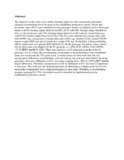| dc.description.abstract | The objective of this study was to define breeding objectives and consequently determine
optimum crossbreeding levels for goats in the smallholder production systems. Profits and
economic values (EVs) were estimated for four genotypes namely (a) original stock or local
goat breeds with 0% German Alpine blood level (OS), (b) F1 with 50% German Alpine blood
level (F1), (c) first backcross with 75% German Alpine blood level (B1) and (d) second backcross
with 87.5% German Alpine blood level (B2). The EVs were estimated for average daily
milk yield (DMY, kg), average post-weaning daily gain (ADG, kg), number of kids weaned
(NKW), mature weight (MW, kg) and 12-month live weight (LW, kg). Profitability in Kenyan
Shilling (KES) without risk was optimal (KES 6038.02) for the B1 genotype. Economic values
without risk for most traits were highest for the F1 genotype, i.e., KES 64.85 (ADG), 24.02
(NKW), −27.55 (MW) and 84.51 (LW). There was, however, a 23% reduction in profits in the
F1 genotype. It was evident that crossbreeding would improve the profitability of the smallholder
farms, but not beyond the 75% grade level. A similar trend was observed when risk
was incorporated. Differences in profitability with and without risk were less than 0.005%
for all the genotypes. However, differences in EVs were large, ranging from −28% to +19%;
DMY had the largest differences. Therefore, incorporation of risk in estimation of EVs for
traits of importance is necessary. This study has also demonstrated that crossbreeding to a
higher grade level is not necessarily compensated for by a high performance in most traits.
Therefore, a crossbreeding program targeting B1 (75%) crossbreds would be desirable for
implementation in the smallholder production systems. | en |

